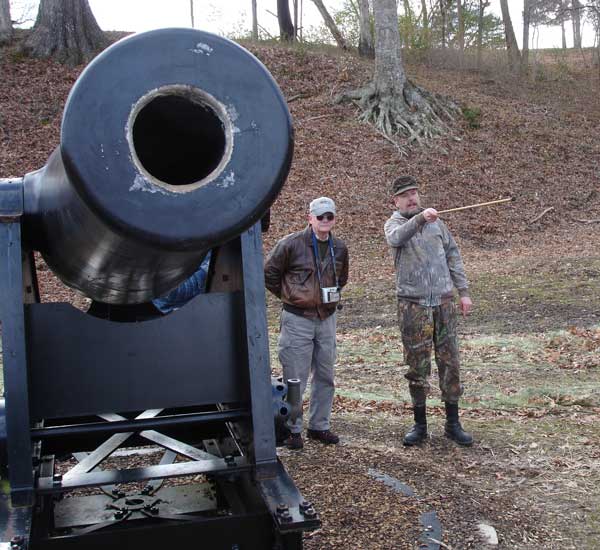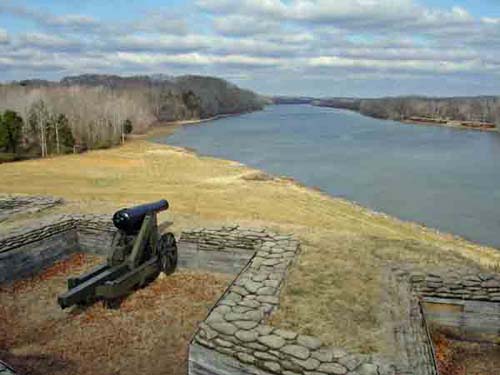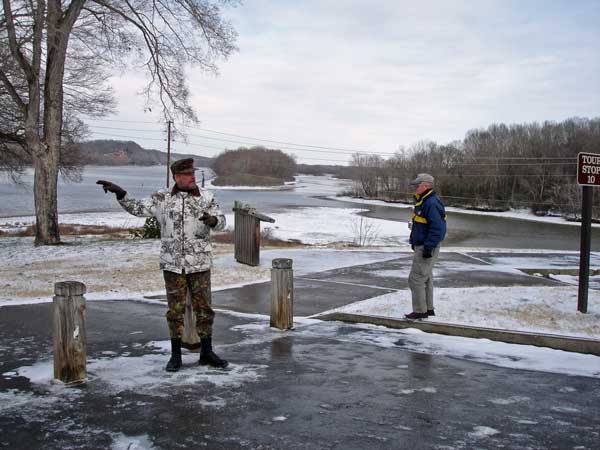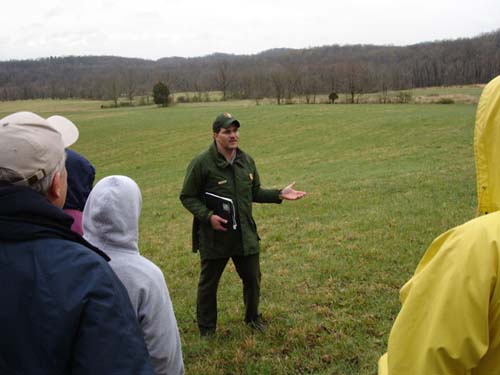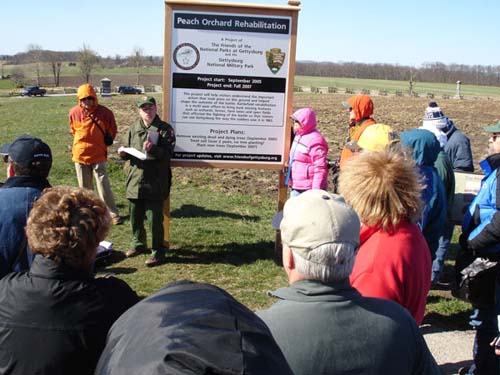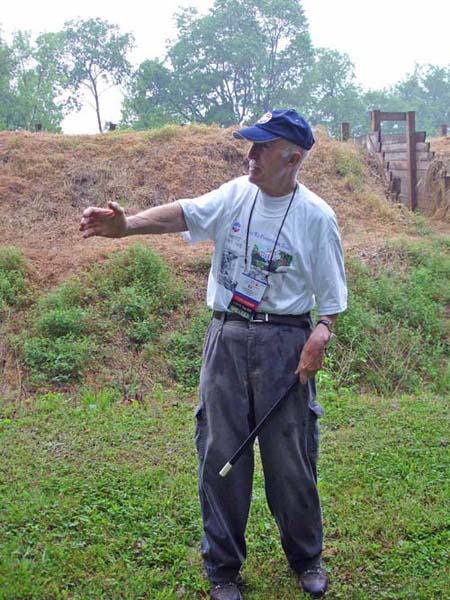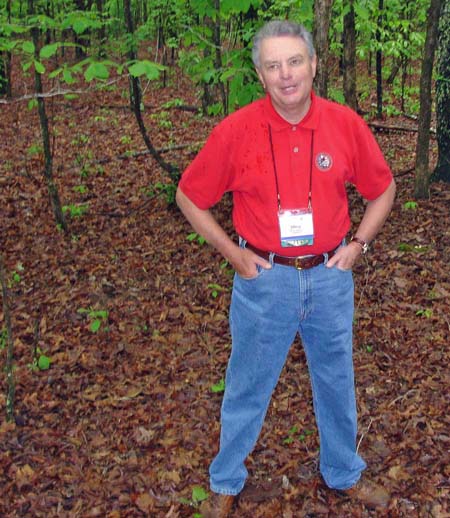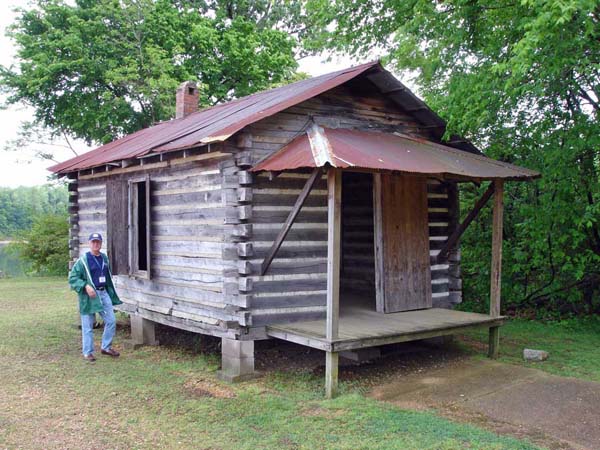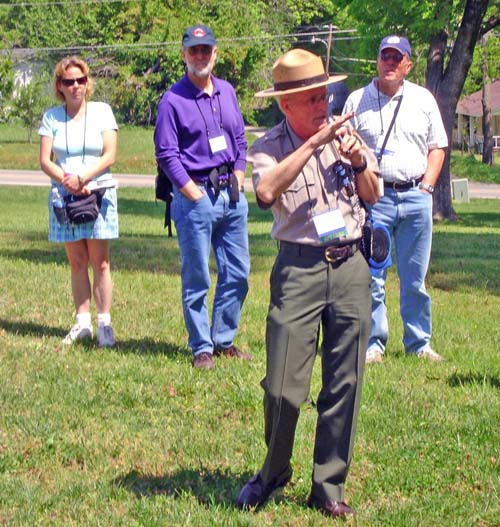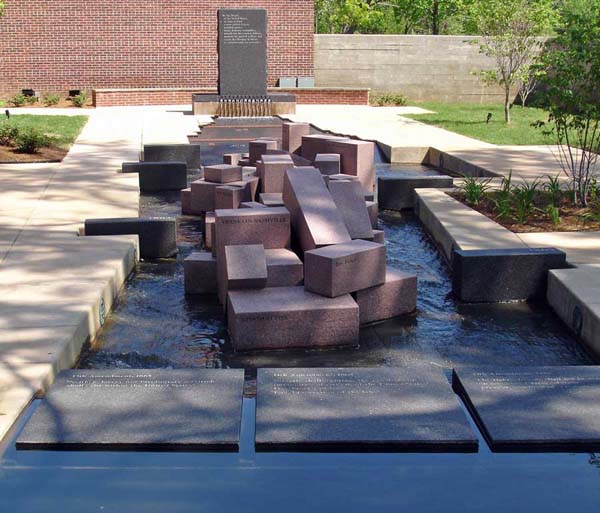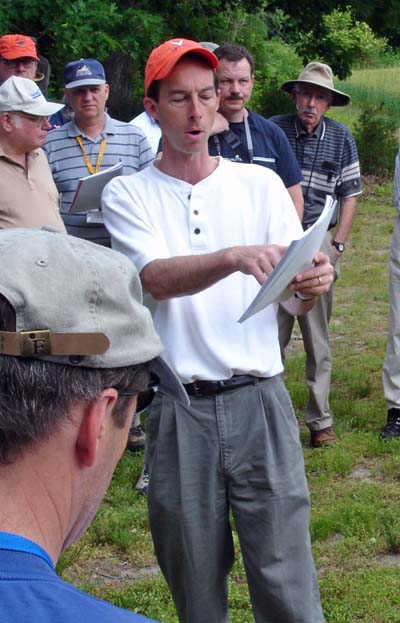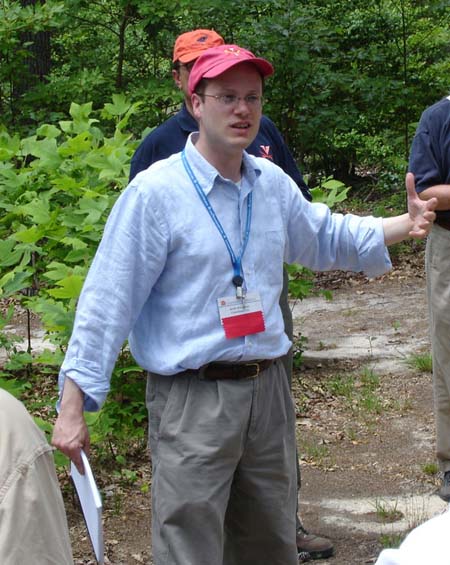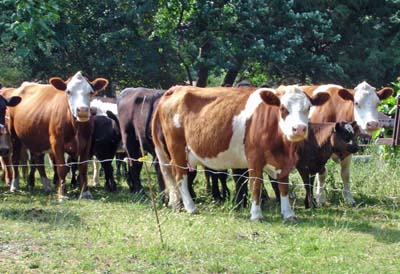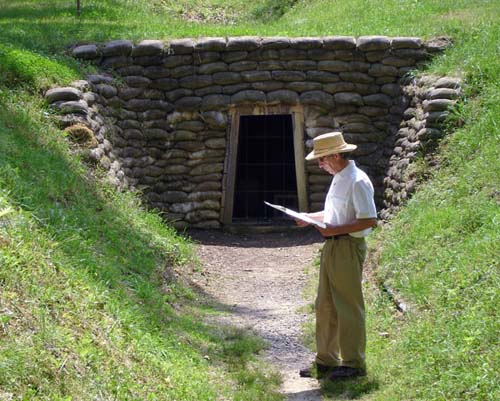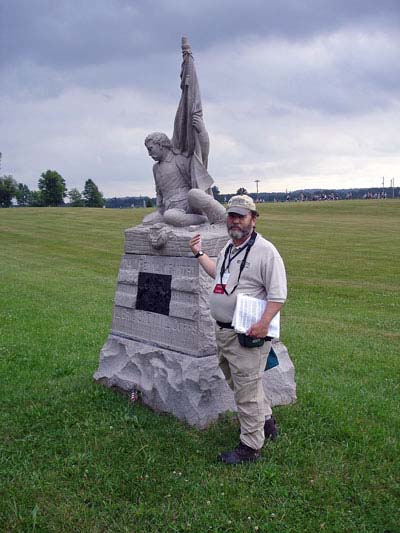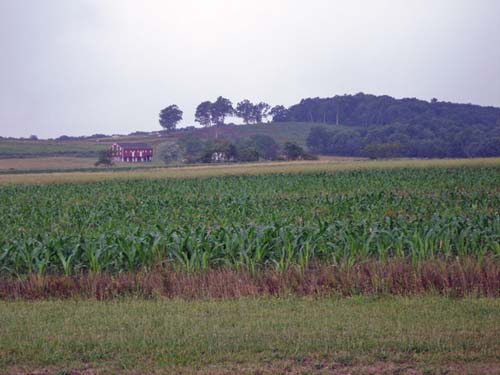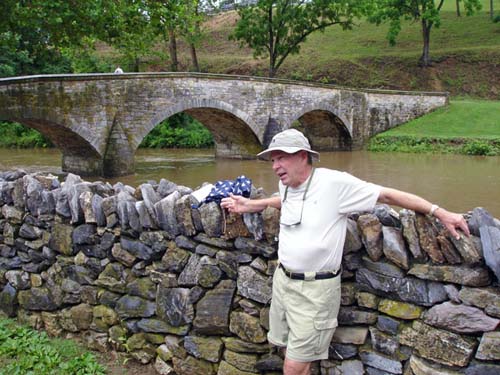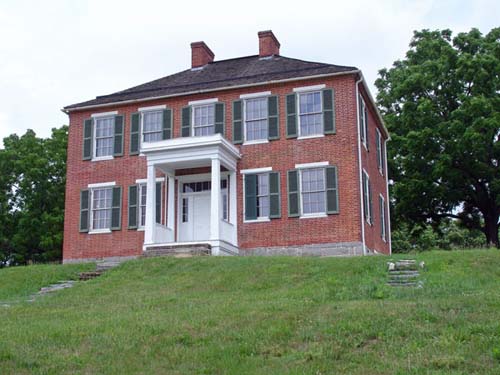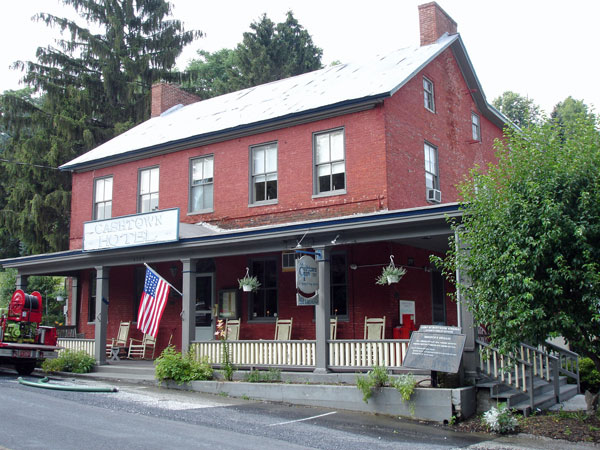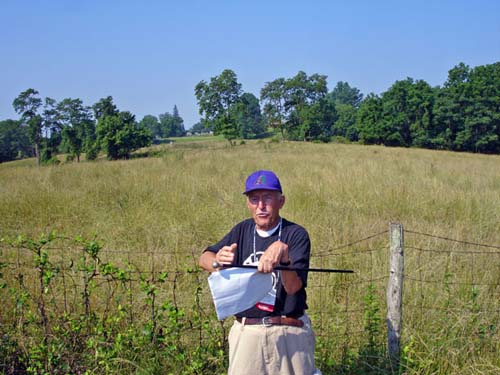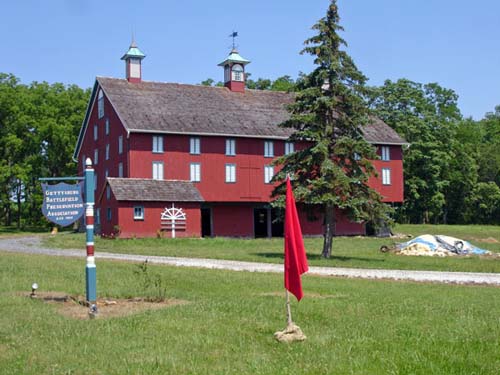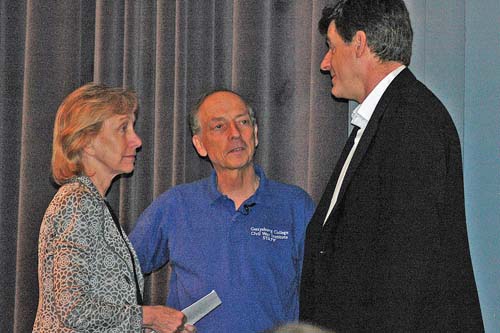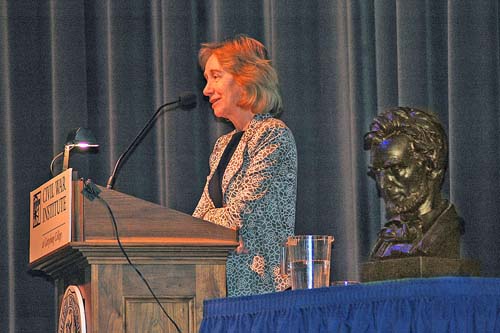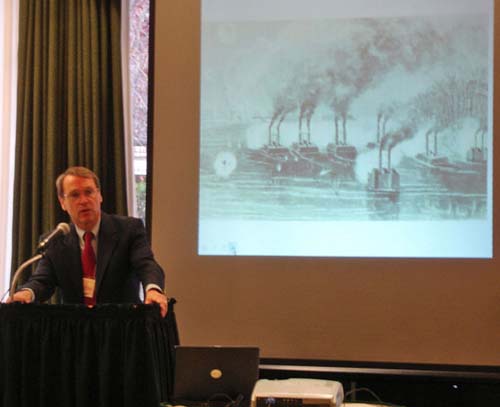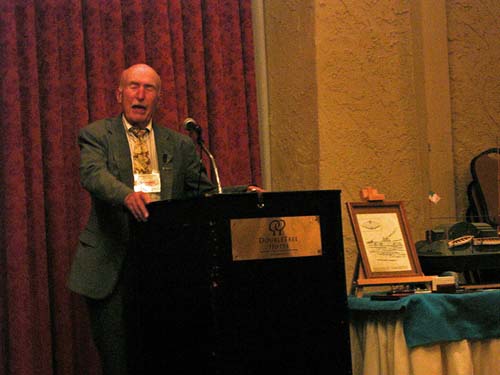2006 Civil War Travelogue
Here are my 2006 Civil War travels:
- February 16-18: Blue and Gray Education Society Staff Ride of Forts Henry and Donelson
- April 8-9: Gettysburg National Military Park seminar on July 2
- April 20-23: Civil War Preservation Trust annual meeting in Memphis
- May 24-28: University of Virginia seminar in Richmond
- June 24-30: Civil War Institute at Gettysburg College
- November 10-12: West Coast Civil War Conference
| Here is a reminder about the reason I write these pages the way I do. They record my experiences and impressions of Civil War trips primarily for my future use. Thus, they sometimes make assumptions about things I already know and focus on insights that I receive. They are not general-purpose descriptions for people unfamiliar with the Civil War, although I do link to various Wikipedia articles throughout. Apologies about the quality of interior photographs—I don't take fancy cameras with big flashes to these events. If you would like to be notified of new travelogues, connect to me via Facebook. |
Blue and Gray Education Society Staff Ride of Forts Henry and Donelson
After having a fun time at the Stones River battlefield (Murfreesboro, Tennessee) last year, I decided on another staff ride with the Blue and Gray Educational Society, February 16-18, this time about the campaign for Forts Henry and Donelson. These were the first Union victories in the Civil War and started Ulysses S. Grant on an upward career that would lead him to command all of the Union armies and eventually become president of the United States. (Although you can tell from my travelogues that I am completely obsessed with the Battle of Gettysburg, I have an increasing admiration for the battles of the Western Theater of the Civil War, particularly those involving Grant and the Army of the Tennessee.) As has become my custom, I preceded my trip by researching the battle and the personalities involved and wrote a series of Wikipedia articles about them:
- Battle of Fort Henry, Battle of Fort Donelson, Western Theater of the American Civil War, John B. Floyd, Gideon J. Pillow, Simon Bolivar Buckner, Lloyd Tilghman, Bushrod Johnson
I also decided to take a map that I drew and create a sweatshirt. I was quite
pleased with the web site named Zazzle.com, which allowed me to upload the
graphics files and delivered the finished sweatshirt in about two days. I also "published" the
design and anyone who is interested in getting a shirt (or coffee mug, etc.)
with these designs can go to this link and purchase one.
|
|
This was a very interesting staff ride (which is a fancy military term for a battlefield tour that emphasizes analyses of strategy and the principles of war rather than simply an historical view) for a few reasons. First, Kendall Gott of the U.S. Army Combat Studies Institute, who wrote a simply superb book on the campaigns, was our leader and he was able to do an excellent job in explaining the strategies, the personalities involved, the command decisions (or lack of them), and the terrain. And he was not the kind of guide who stands around and fills time reading lengthy passages from the Official Records. That second point was very important because the other really interesting aspect of this tour was that it coincided roughly with the 144th anniversary of the battle, which meant that we were subject to the same weather that the soldiers encountered. And it was actually quite similar—the first day started off reasonably comfortable, as it was on February 12-14, 1862, but then a cold front blew in with about 3 inches of snow and temperatures dropped below 20°, almost as cold as the night of February 14 that year. (Fortunately for us, we learned from the mistakes of the Union soldiers who threw away their overcoats and blankets on the march, and we were well bundled up. It was really bitterly cold, particularly anywhere near the Tennessee or Cumberland Rivers.)
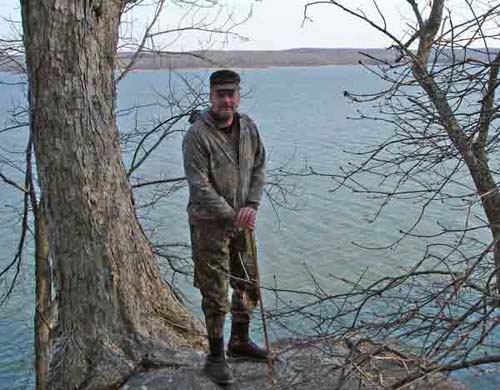 |
Ken Gott above the Tennessee at Ft Heiman |
We started the staff ride Thursday afternoon with a five-hour introductory session in a hotel meeting room in Clarksville, Tennessee, featuring presentations and discussions with Ken and Parker Hills, who had been on last year's Stones River staff ride. (Len Riedel, the BGES executive director, was there, too. Quite knowledgeable about Civil War and military topics.) There were only four attendees on the ride, which meant that we fit comfortably in a van and could ask all the stupid questions we wanted.
On Friday morning we drove about 45 minutes to Dover, Tennessee, the location of Fort Donelson, and we concentrated on the engineering aspects of how the fort was constructed and how the two river batteries figured in the battle. I was quite impressed with how difficult it would have been to put the big guns out of action that day. They were hard to see from the water and the poor Union gunboats were essentially sitting ducks. I also was surprised to find that the 15 acres that comprised the actual Fort Donelson was not flat, but had a very significant ravine right down the center. Then we drove across the Land between the Lakes National Recreation Area to find Fort Henry. I was disappointed to find that Fort Henry is completely underwater, near the center of a giant lake. Although it was on the banks of the Tennessee River, the river was dammed up in the 1930s and that portion is now called Kentucky Lake. During the time of the battle, February 6, 1862, Fort Henry was actually inundated by the floodwaters of the Tennessee, but now it is even farther underwater and is marked only by a small navigation beacon. Too bad. Then we drove some more, to the Kentucky side of the river, to the rarely visited Fort Heiman, which is a tiny area surrounded by ancient entrenchments on the top of a steep bluff overlooking the river. The fort was intended to provide cover for Fort Henry, but was abandoned before the main fort surrendered. We finished the day with another 2.5 hours in the meeting room, reviewing aspects of the campaign and getting a detailed briefing on the ironclad gunboats that figured prominently in the two battles. A full day and a bit tiring.
|
|
On Saturday morning we woke up to 3 inches of snow and made our slippery way back to Fort Donelson, where we concentrated this day on the land tactics of the battle. This was my first visit to a snow-covered battlefield and what people say is true: you really can get a much better appreciation for the shape of the terrain when it is covered in snow. (Now I will take opportunities to visit Gettysburg in the winter a bit more seriously.) I really had no idea how rugged the terrain of Fort Donelson is. Although I have seen maps that show all of the ridges and hills, it is another thing to imagine infantryman trying to assault up some of those very steep ravines. When we visited the line that was defended only by the 500-man 30th Tennessee Infantry Regiment, and assaulted by two brigades of Brigadier General Charles F. Smith's division, I thought it was considerably more difficult than the terrain of Culps Hill; Parker compared it to the terrain around Vicksburg. (Every time Parker spoke, he brought up battles, units, and generals from Vicksburg. This staff ride turned out to be almost like the first part of an early, extended Vicksburg campaign!) I also had no idea that Pillow's assault on February 15 covered so many ridges or that Forrest's escape over Lick Creek was through such a broad expanse of icy water.
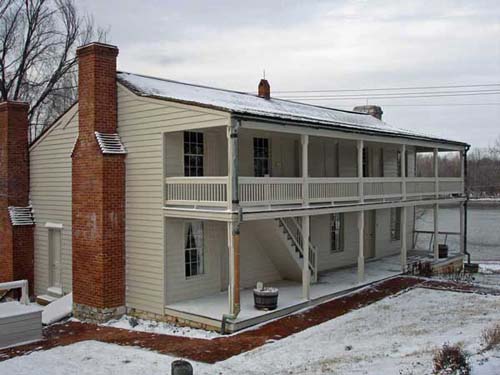 |
Dover Hotel, site of Buckner's surrender |
An interesting part of the day was climbing up to the top of the hill overlooking Indian Creek where Maney's battery was situated. Another was seeing the Dover Hotel, where the surrender of Simon Buckner to Ulysses S. Grant occurred on February 16. And it was also interesting that when people were disoriented on the field (which, unfortunately, has a number of private residences on key parts of the February 15 assault) they got me to open up my coat and studied the map on my sweatshirt. Speaking of the battlefield, it is pretty well preserved in a number of places, including some very nice entrenchment remains. The Visitor Center is quite dinky with a small, less than riveting museum. They do have a 127.5-lb cannonball (which may be a disguised bowling ball for all I know).
We finished up Saturday evening with a 90 minute "integration phase" of the staff ride in which we discussed the principles of war and what we had learned and talked about a number of what-if scenarios. Then there was the ending "banquet" in a local fried catfish restaurant. All in all, a great time, with interesting people both as instructors and attendees. I hope to be able to have more staff rides with BGES in the future.
National Park Service Gettysburg Seminar
My first trip to Gettysburg this year was to attend another National Park Service seminar. Before I start on the actual contents of the seminar, allow me to rant for a paragraph on the inconveniences of the first really bad travel weekend I have had in my Civil War excursions. My friends at American Airlines left me with a dilemma -- my flight was late in arriving in Chicago and they gave me a choice of a six-hour layover for the next flight to Dulles or a two-hour if I was willing to go to Reagan National instead. Since the two airports are relatively close, I said sure, send me to Reagan. But would my checked bag have any difficulty? No, they said, but you'll have to inform them at the airport; people on the telephone cannot handle this situation. So I went to the friendly folks at the Admirals Club and they went clickety-clack on their computer terminal and assured me that it was all squared away. Nothing to worry about. Don't worry your graying temples about anything, Big Guy. Well, even though I was so assured, I walked away feeling like James Longstreet after he nodded to George Pickett. It just very well might turn out OK. Do I really need to relate the end of the story? Oh, OK. At Reagan, I dutifully waited for an hour for my bag and it never arrived on the carousel. The friendly ladies at the baggage department had no idea what was happening, but assured me that they would take care of it. The bag was not registered in the system. What is the nearest airport to Gettysburg? Well, Harrisburg, I suppose. OK, don't worry... So I drove to Gettysburg in heavy rain, arriving four hours later than I had hoped. And five minutes after Wal-Mart closed, meaning that the underwear, socks, umbrella, and toiletries I had hoped to buy would have to wait for another day. Many hours went by before the saga completed, but I will complete this part of the story before going to the happy part. I eventually made it to Wal-Mart at lunchtime the next day and got everything I needed, but I ended up calling and prodding the airlines multiple times to achieve satisfaction. First, the bag apparently made it to Harrisburg on United Airlines. The friendly lady on the phone indicated that the next step was to inform United to send it over to American and then American could be motivated to have it delivered. Eventually, the bag showed up at about 8 p.m. I cannot imagine the hassle that would have ensued at the bag had not arrived before I checked out of the hotel. I consider myself very lucky.
|
|
Anyway, back to the National Park Service. I attended an excellent seminar in 2004 on the first day's battle. (This was before I had the presence of mind to record and publish in gory and obscure detail all of the aspects of my Civil War traveling.) This was the first of three biannual follow-ups. The weekend was entitled "The Most Shocking Battle I Have Ever Witnessed, The Second Day at Gettysburg." We started with three one-hour lectures in the condemned Cyclorama building. (OK, it's not really condemned. The Cyclorama itself has been closed for renovation and relocation to the new Visitor Center in 2008, but there are still NPS employees working in the bowels of the building, apparently stoking boilers that are heating the auditorium enough so that giant fans in the hallway are required to cool down the room, despite the 40° temperature outside.) You may wish to read some of my Wikipedia articles about aspects of the battle on July 2: Battle of Gettysburg, Second Day, Culp's Hill, Cemetery Hill, Little Round Top.
- LTC William Hewitt, US Army Retired, started off with "On the 2d July ... we attempted to dislodge the enemy ..." Colonel Hewitt, who had also presented at the 2004 seminar, returned for another formal tactical look at an aspect of the campaign, using modern military analysis techniques. (When he was on active duty, he wrote tactics manuals for the Army, making him the modern William J. Hardee. I am sure that if Hardee were alive today, he would also create PowerPoint slides in ALL CAPITAL LETTERS. Well, maybe not, since the Teletype that inspired this style had not been invented then.) He examined Lee's options for July 2 and demonstrated how moving into a defensive posture would not have been wise for the Confederates. He analyzed the terrain in a very easy to understand way and showed how the battle progressed based on its restrictions. He generally agreed with Troy Harman that Cemetery Hill, not Little Round Top, was the primary objective of all of Lee's assaults that day. The thing I found fascinating was how the title of his talk completely turned around some of the common conceptions of the Union position. Although we always speak about the importance of the Baltimore Pike as Meade's primary line of communications, Hewitt argued that Lee in fact did not want to cut the Union line of communications, which would have caused Meade to fight in his current position. Lee stated that he wanted to "dislodge" the Union army from its favorable position, presumably to maneuver it into a more favorable battle elsewhere.
- Karlton Smith "To consider every contingency, which might arise" — James Longstreet and Samuel R. Johnston in the art of reconnaissance and the countermarch on July 2, 1863." Karlton, whom I had joined two years ago on a field tour of Junius Daniel's brigade, gave a detailed, and a bit dry, presentation about the famous countermarch on the afternoon of July 2 and how Johnston gave a rather confused report on his reconnaissance that morning for Lee.
- Scott Hartwig gave an interesting presentation, "Unwilling Witnesses to the Rage of Gettysburg: The Experience of Battle, July 2, 1863, " on what happened to the regular soldiers during the battle, emphasizing their deviations from tactical drill and how they dealt with all of the problems such as weather, fatigue, food, etc. Scott is a very engaging man who is the supervisory historian (I guess that is the equivalent of the pointy-haired boss in the Dilbert cartoons) and I finally was able to introduce myself to him during a break. I was simply amazed to find that he has spent 26 years at Gettysburg National Military Park. I suggested to him that he must have started while he was in elementary school. (I am such a charmer.)
Now it was lunchtime and everyone else waddled over to a Chinese food buffet or another buffet of unknown national origin named after General Pickett. (Does anyone else find that thought distasteful?) I did my Wal-Mart excursion, over on York Street. Wal-Mart really is a natural wonder. If there is something that you can't find at Wal-Mart, you probably did not need it.
In the afternoon, the 150 or so of us broke up into three groups for programs out on the battlefield. I signed up for:
- Troy Harman's bus tour entitled "Meade's July 2 Offensive Plan Reconstructed." (The tour actually had nothing to do with Reconstruction, which occurred after the Civil War. I'm sure Troy didn't mean to confuse anyone. :-)) I had seen some of this material before, but I always enjoy busing around with Troy, as you have seen in some of my previous postings. The premise here is that George Meade is often seen as a strictly defensive general at Gettysburg, but in fact he seemed to have been hatching plans for an offensive on July 2. He wanted Henry W. Slocum to attack the troops of Edward "Allegheny" Johnson on Benner's Hill with over two Union corps. One really has to be in awe of Meade, whose knowledge of the battlefield was limited to receiving messages on July 1 and then a horseback reconnaissance that was conducted almost entirely in the dark on July 2. He seemed to have an instinctive knowledge of the terrain and the troops and how they would interact. And all of this just four days after being thrust into command of the most important army in the Eastern Theater. He was a topographical engineer by training (and a real whiz at lighthouse construction), but is still a very underrated man. The tour was cold and rainy and the windows on the bus steamed up enough so that it was difficult to see out. But we got a very good understanding of the terrain on either side of Wolf Hill, how it affects the defense of Culp's Hill and Power's Hill, and how lonely it made Henry W. feel. We stopped at a beautiful view on the southern edge of Benner's Hill, where you could clearly see The Gap between Wolf Hill and Culp's Hill and why Henry Hunt had to use 45 artillery pieces to keep the Confederates out of that area. The activities in this area are very poorly publicized and I look forward to a book that Troy is authoring on the subject.
That evening, we had a group dinner at the Pike Restaurant, which is just south of the fashionable Gettysburg Econolodge on the Baltimore Pike. (That was the first motel I ever stayed in at Gettysburg. I have not scheduled any return visits. Enough said. I stayed this time at the Quality Inn, right next to the park Visitor Center, and it's quite reasonable.) The food was pretty decent, although getting what seemed like 200 people to go through a single buffet line must have left the people at the end of the line feeling like Confederates just before Appomattox. After dinner, another program:
- Kathy Harrison, senior historian at GNMP, gave a lecture and slide show entitled "The Landscape of the July 2 Battlefield." This was a pretty interesting look at the process at the Park Service has been going through to determine what the state of the battlefield was in 1863—in terms of foliage and fences and terrain—and trying to recommend what changes would be acceptable and affordable so that current viewers can understand the choices that generals at the time had to make. I wholeheartedly endorse this effort. Kathy had a lot of interesting slides, although I will have to emphasize "a lot."
Sunday morning Gettysburg awoke to sunny skies and brisk temperatures. The final program was:
- Eric Campbell, Park Ranger, "The Key to the Entire Position", The Peach Orchard, July 2nd." I wondered in advance how he would fill up three hours with this relatively straightforward action, and I was very pleasantly surprised that he did a really great job (dare I say, a Peach of a job), keeping me interested the whole time, despite the windchill distraction. He didn't limit himself to the literal boundaries of the orchard (which is currently treeless for a replanting program) and we followed Barksdale's Brigade when it turned north and went as far west as the Trostle farm, covering a lot of artillery details. Outstanding job.
All-in-all, a great weekend, even factoring in travel woes and some light rain. I'm off in two weeks for the Civil War Preservation Trust annual meeting in Memphis! Let's hope the Tennessee tornados and the American Airlines baggage handlers have calmed down by then.
Civil War Preservation Trust Annual Meeting, Memphis
I traveled to Memphis, Tennessee, for the annual meeting of the Civil War Preservation Trust. The trust operates two big meetings annually—the regular annual meeting in the spring and a smaller one for the donors called the "Color Bearers" in the fall. This meeting was entitled "Crossroads of Conflict: Shiloh and Corinth." And, they threw in a lot of Nathan Bedford Forrest as well. I arrived on Wednesday, April 19, after a flawless pair of flights on American Airlines, now out of their slump of the previous trip. My bag not only arrived, it was on the carousel in under 10 minutes. The meeting was in the historic Peabody Hotel, which is very nice, noted primarily for a ceremony every day at 5 p.m. in which a group of ducks swimming in a lobby fountain march on a red carpet to the elevator and are taken upstairs to their "mansion" on the roof. Dinner that night was on our own and my friend Don Wiles and I went down the street to the Rendezvous, which has been recommended on some web site as the most popular Memphis Barbecue restaurant. And I have to say that it was fantastic! The restaurant itself was very casual, but the pork ribs, done in the dry style that they favor here, were just great, probably the best ribs I have ever tasted.
|
|
Thursday
The Color Bearers were up early on Thursday for a special tour of Fort Pillow, led by Ed Bearss. I have written about Ed before, and he remains the premier Civil War historian and battlefield tour guide in America. It was a long two-hour bus ride, despite only going 40 miles as the crow flies. And we drove through a spectacular, severe thunderstorm. At 8 a.m. it was as dark as night. By the time we reached Fort Pillow, the rain had diminished quite significantly and the only aftereffects were very muddy trails, slippery up and down the ravines. Some khaki pants in the group came back covered in big mud smears. The Battle, or the Massacre, of Fort Pillow was an interesting engagement in 1864 in which Nathan Bedford Forrest attacked and captured the fort on the Mississippi, causing enormous casualties among the defenders, half of whom were white Tennessee Unionists, the other half black artillery soldiers. Accusations have persisted that the Confederates shot many of the soldiers after they had surrendered; the black soldiers had significantly higher casualty rates than the whites. I wrote a Wikipedia article about the battle, as I try to do beforehand whenever I take a tour of this kind. Ed presented an interesting insight as to Forrest's culpability: normally Forrest led his battles from the front, but in this case he was in the rear after ordering the assault and waited 20 minutes before he arrived on the scene and attempted to restore order. In the modern army, a commander with his behavior would be considered completely responsible.
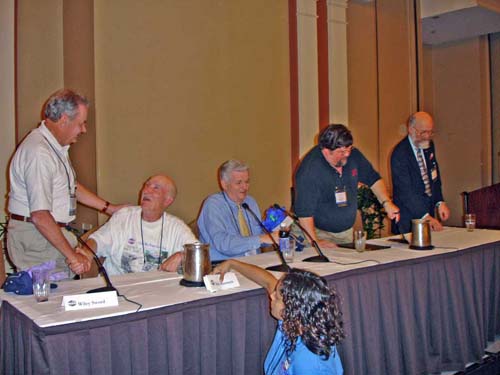 |
Panel: Wiley Sword, Ed Bearss, Larry Daniel, Brian Wills,
Dick Summers |
In the afternoon we had two lengthy panel discussions with five distinguished historians: Dick Summers (whom I did not even recognize in a big white beard and only halfway through did I realize that he is the guy you always see on the History Channel standing in front of Little Round Top, dressed in a suit and a goofy hat); Brian Wills (author of a Forrest biography); Larry J. Daniel (author of books on Shiloh and other Western Theater topics); Wiley Sword (ditto); and Ed Bearss. The first panel discussion was on the first Corinth campaign (the Siege of Corinth) and the members had a good deal of difficulty keeping on the subject, branching tangentially into the second panel, which covered general topics of leadership at Shiloh. A few insights that I felt were interesting: Dick thought that PGT Beauregard was the second-best army commander in the Confederacy, after Robert E. Lee. (In my opinion, given the competition, that is very weak praise indeed.) Wiley addressed the controversy of whose fault it was that Lew Wallace got lost at Shiloh; he felt that both Grant and Wallace were at fault (way to stick your neck out, Wiley). The most spirited part of the discussion was when someone from the audience asked whether the Hornet's Nest at Shiloh was actually a myth. Larry explained that an episode of Battlefield Detectives for which he and Wiley were interviewed came up with that conclusion, but all of the panelists vehemently denied the claim. (Really outrageous. I have to say that I have very little respect for that television series.)
That evening we had a nice reception and private dinner for the Color Bearers. Brian Wills spoke after the dinner and I was impressed at how well spoken, humorous, and to the point he was. I regret that I did not sign up for one of his tours the following days. Then we joined a large dessert reception and listened to period trumpet pieces by Gary Gazaway.
Friday
Although the forecast called again for severe thunderstorms, we gamely rose for another day of life on the Flying Dutchman bus lines. (This weekend there were actually 15 hours of bus rides to endure. It is rather amazing how tiring it is to simply sit in a bus seat and chat.) Fortunately, the weathermen were wrong and although we saw nasty storm clouds all day, there was very little precipitation. My bus ride today was to Shiloh (see my Wikipedia article) with Wiley Sword. Wiley spent most of the two-hour bus ride giving us a background on the campaign, starting with the appointment of John C. Frémont, believe it or not. What came next was the only disappointing part of my entire trip. We found out afterwards that all the other buses to Shiloh spent a few hours at the battlefield, where a box lunch was provided. Wiley apparently decided that we would like a sitdown lunch of catfish instead of visiting the battlefield, so we spent a little more than an hour driving and walking around before we visited the Hagy Catfish Hotel, where I had one of three portions of fried catfish I was served this week, as well as one of four fried chickens, and one of five hush puppies. (I honestly do not know how people in this area survive their diet. I told one of the staff members that they should insist on having us fill out our wills with the CWPT listed as heirs before feeding us these heart attacks on plates.) So we simply raced by the Shiloh Church, the Bloody Pond, Fraley's Field, Dill Branch, and a number of other interesting places. We did stop for a few minutes on the sunken road at the Hornet's Nest and visited the site in the woods where Wiley asserted that Albert Sidney Johnston was actually mortally wounded, not where the National Park Service has placed his monument. After lunch, we had an hour to spend in the visitor center, national cemetery, and Pittsburg Landing. This was probably the best part of the day because I got a good sense of the terrain around the landing and I got some photographs of some very unusual artillery pieces. (These photos will go into my Wikipedia article one of these days.) Oh, I also sat next to Wiley at lunch and got to debate with him about whether Sidney Johnston did a decent job in the battle or not. I maintain that he really screwed up a number of things, violating at least half of the Principles of War. His counterargument was essentially that these armies were very new and there was little experience trying to lead so many men, and I guess I have some sympathy for that argument. Some.
|
|
For dinner, there was a series of events planned at Mud Island River Park. (If you have ever seen the Tom Cruise movie, The Firm, you may recall the monorail that went out over the river to an island and that is where we went, although we went by bus. Part of that film was also shot on the roof of the Peabody Hotel.) Mud Island is approximately 1 mile from the hotel by air, but our bus driver managed to turn it into 45 minutes by getting lost. I call it the Lew Wallace Memorial bus ride. (For my Gettysburg friends, it could also be called the John W. Geary Memorial bus ride.) There was a museum about the Mississippi, a tasting of Rebel Yell bourbon, a speech by Ed Bearss about the explosion of the riverboat Sultana, a concert by the 5th Alabama Infantry Regiment Band, and a buffet Southern dinner out on the patio, overlooking the river. I do not think it is necessary for me to describe the menu of the dinner. I assume you have been paying attention.
Saturday
|
|
Finally, beautiful weather, sunny and not too hot. We drove to Corinth, Mississippi, this time under the guidance of Ranger Jim Minor. We started at the new NPS Interpretive Center, which is really quite nice. Very professionally designed and a lot of information is available. To approach the building, you take a long winding sidewalk that has been decorated with battlefield detritus, such as knapsacks, bullets, rifles, and tin cups, all reproduced in bronze and embedded in the concrete. Inside there are two movies—one about Shiloh and the other about the two battles of Corinth (see my Wikipedia article about the first battle and second battle). (I find it amusing that the Corinth tourism people label Shiloh as being part of the "Corinth Campaign.")
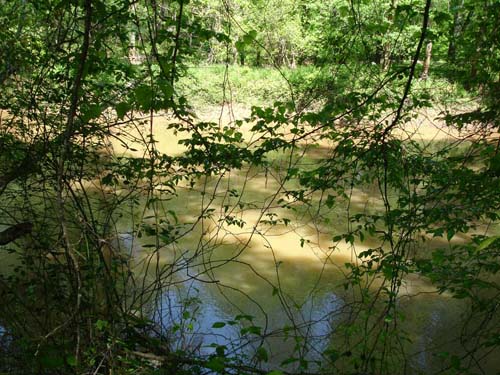 |
Hatchie River and missing Davis's Bridge |
The Corinth video features an attractive young actress doing the narration and showing you around the battlefield. I checked her out on the Internet and found out that Denice Hicks previously had the female lead in Ernest Scared Stupid and a lesser role in another Ernest movie. In the rear of the building is a very interesting fountain/sculpture that attempts to show the history and results of the Civil War by placing large marble blocks into a flowing river. Also in the back is a large sloping hill, the former site of the famous Battery Robinett, where some of the fiercest fighting of the second battle of Corinth took place. We had a nice box lunch in the visitor center. Can you guess what it contained? The only variation in cuisine this time was that mashed potatoes were included to balance out the deep-frying. We drove around some more and saw Battery F and the downtown railroad crossing, although a fence kept us away from the actual track crossing square, which would have been a cool photograph. We concluded the day by driving to the site of the battle of Davis's Bridge, near the town of Pocahontas, Tennessee. That was pretty interesting, although the bridge itself was burned during the war and never rebuilt. But finally we saw a totally pristine battlefield that had been preserved with the assistance of CWPT. There was no development around at all, just a pretty landscape inhabited by the cast of the movie Deliverance.
My long weekend finished up with the gala banquet at the hotel. Earlier, I told some friends that since the Civil War was fought between North and South, the North deserved equal representation on food. Fortunately, my wishes were heard and we had a typical northern hotel rubber-chicken banquet dinner. And the chicken was not fried! We started with a reception in which the Alabama band played again and they were quite enjoyable, but a bit powerful for the size of the room. After dinner, there was a series of presentations awards for preservation activities, organizations, and individuals. For instance, the mayor and city aldermen of Franklin, Tennessee, received an award for all the progress they've made in turning around a bad development situation. The head lady alderman gave a speech in which she admitted she wasn't in office at the time, but ended up taking credit. She has a budding political career ahead of her. The highlight of the evening was a touching video interview with Brian Pohanka, who received a posthumous award named for Ed Bearss, accepted by Brian's widow, Cricket.
There were a few more lightweight activities scheduled for Sunday morning, but I had early flight to catch (and these AA flights were flawless, too!). I had a great time with the Civil War Preservation Trust, despite some of my logistical belly aching, and hope to join the group again in the future.
University of Virginia Seminar in Richmond
Based on my great experience last year at the University of Virginia program held in Charleston, I decided to get in on the action in Virginia this year. They hold a seminar every year, usually on the campus of the University of Richmond. The program this year was "From Cold Harbor to the Crater, Grant versus Lee." On Tuesday, May 23, I flew to Washington Dulles, rented a car, and overnighted in Fredericksburg, which is about halfway to Richmond.
On Wednesday, I had only until midafternoon free and decided to see the North Anna battlefield on the way to Richmond. An interesting story resulted. Not remembering to bring the appropriate map, I stopped by the Spotsylvania County tourist office, teeming with Civil War information. Well, this was like dropping in at Democratic Party headquarters and asking for a Republican voter registration card. First, they denied having any information or maps about a battle in alien Hanover County. They said I would have to go to Richmond to find that information. I found a comprehensive Overland Campaign map quickly in the rack. Then the man says, "You know that it isn't there anymore." Huh, what isn't there? The North Anna River? "No, there is no battlefield park." I opened the brochure and showed them the park, named "North Anna Battlefield Park." Oh, well that must be a county park! (Ugh.)" So I found the park and it was modest, but worth visiting. Unfortunately, it does not cover the major combat area, Jericho Mill. I was the only one there besides the squirrels, so I had a nice walk through the woods to the heights overlooking Ox Ford. This was the apex of the famous "inverted V" that Robert E. Lee set up as a trap for Ulysses S. Grant. Visiting battlefields is always educational because you can learn a lot from the terrain and I was astonished to see that this position the Confederates defended was practically like the cliffs on Omaha Beach. It would have been amazing if the Union assault ordered by James H. Ledlie (while he was drunk, history tells us) could have possibly succeeded. The park has outstanding interpretive markers, much better than those at a typical National Park Service battlefield. They were placed by my pals at the Blue and Gray Educational Society and a local granite company. Each was accompanied by a large, clearly marked topographic map.
I last visited Richmond in 1970 and frankly remembered squat about it. So I wanted to get a little sightseeing in before the seminar grabbed all my time. First, to the Museum of the Confederacy and the Confederate White House. The latter was Jefferson Davis's home and office during the war and it was an interesting tour of a magnificently restored mansion, with many period pieces. We had an excellent tour guide, a local history graduate student, who was able to answer even the most trivial question, and this group certainly asked a lot. (It was almost like there were tax assessors in the group. They asked about the provenance of every single piece of furniture and knickknack in the building! What's that? Is that original? Is that original? What's that? Is that original?) The museum was nicely done, with a lot of artifacts such as uniforms of famous generals. (Boy, those guys were small. Ally McBeal could fit into those uniforms.) There was a large exhibition about the Confederate Navy and also about art created by Confederate soldiers. Next, I drove over to Hollywood Cemetery, which is a beautiful tract on rolling hills overlooking the James River. I stopped by the graves of George Pickett, Fitzhugh Lee, Jeb Stuart, and Jefferson Davis. Then it was off to the University of Richmond, a leafy campus in a posh residential neighborhood. (Someone told me recently that Richmond was still rather seedy, but all the places I visited outside of the small downtown were strikingly attractive. If one could deal with the humidity of Richmond summers, it would be a very interesting place to live.) I regret not budgeting more time to see Richmond. I will have to come back someday soon, hopefully on a tour of the Peninsula Campaign, if I can find one.
After the stressful time I had at the Gettysburg college dormitories last year, I decided to skip another dormitory stay this time and picked a local motel, about 15 minutes away. (Pretty nice. Quiet and comfortable, free Internet access.) The only disadvantage to this approach is that these programs have lengthy breaks built into the schedule, which makes it a little awkward if you are not staying on campus. I also yielded to my reluctance to stay out really late and skipped the 9 p.m. dessert buffets. Following my standard operating procedure, I researched the topics to come and wrote Wikipedia articles:
- Overland Campaign (actually, just a new map, which I put on a T-shirt you can order: http://zazzle.com/hjespersen)
- Battle of Haw's Shop
- Battle of Totopotomoy Creek
- Battle of Cold Harbor
- Siege of Petersburg
We started off with a day and a half of lectures, as follows:
- Grant Versus Lee Continued: A Tactical Overview from the North Anna through the Crater (Robert E. L. "Bobby" Krick) — The reason it says "continued" is that the previous years' seminars covered the Wilderness and Spotsylvania Court House. Bobby turned out to be the technical star of the conference. All of the other presenters at some time during the week had to ask his help with questions about local battlefield issues
- Limitations and Hesitations: Grant, Meade, and Their Generals in June-July 1864 (William W. Bergen) — An overview of the command structure of the Army of the Potomac. Gary Gallagher got all hot and bothered that Bill was introducing PowerPoint into the program, and I will have to say that I have never seen someone use PowerPoint and also read from a script. I guess I am simply too corporate. He made an interesting point about how Grant retained George G. Meade as commander of the Army of the Potomac; apparently, President Lincoln pressured him to do so because the Radical Republicans were politicking to get Joe Hooker restored to command, which Lincoln opposed.
- Assessing Grant and Lee: The View from the Home Fronts (Gary W. Gallagher) — This was an interesting talk, as Gary's normally are, but one whose major themes I have heard before: an explanation about how Grant was called a butcher, but Robert E. Lee lost just as many men proportionately. (Of course, the awful truth was that Lee could not afford to lose anyone, whereas Grant had more liberal reinforcements available.)
- "Breast Works Are Good Things to Have on Battlefields": The Evolution of Confederate Field Fortifications in the Overland Campaign (Keith S. Bohannon) — This turned out to be less of an explanation of the engineering of field fortifications and more about some of the tactics dealing with them at Cold Harbor.
- Francis Channing Barlow: From Harvard to Petersburg (Joan Waugh) — Joan is a professor at UCLA, whom I met at Charleston last year, and she gave a very professional overview of Barlow's life and spent some time on his failures during the Siege of Petersburg (particularly the battle of Jerusalem Plank Road). I later asked her about the famous Barlow-Gordon incident from Gettysburg and she told me she believes that historians are starting to become more sympathetic to this tale, which has until recently been considered entirely apocryphal.
- Sixty-two New Confederate Generals at Petersburg (Robert K. Krick) — This was the highlight of the lectures for me. I had never seen Bob lecture before and I thought he was humorous, well structured, and very informative. He and Gary seemed to have a running rivalry, so barbs were thrown all week. During of the Overland Campaign, the Army of Northern Virginia was authorized to have 62 generals and they received 62 new ones by the time of Petersburg. This looks like 100% attrition, although obviously some of the old-timers stuck around and some newcomers choked.
- Behind the Lines: The Home Front Experience in Civil War Petersburg (Caroline E. Janney) — Caroline is a recent UVa Ph.D., now heading for Purdue, and she gave a really excellent presentation about the civilians at Petersburg during the "siege." Very well-spoken and informative.
- Recent Representations of the Battle of the Crater (Stephen Cushman) — Stephen is a professor of English and he gave an interesting talk concerning two novels written about the battle of the Crater, how they were structured, and how they processed historical material. Based on his analysis, the one by Richard Slotkin looks pretty good, the one by Duane Schultz seems pretty superficial. He also showed an eighty-second clip of the movie "Cold Mountain." The academic types at the conference seemed to think that this feat was the height of technology.
- Book Reviews (various faculty) — This was held Friday night, after a long day of battlefield touring, and I did not feel like driving back to campus after cleaning up. Each of the faculty members supposedly talked about recent books they admired. Well, I have enough books for the moment.
|
|
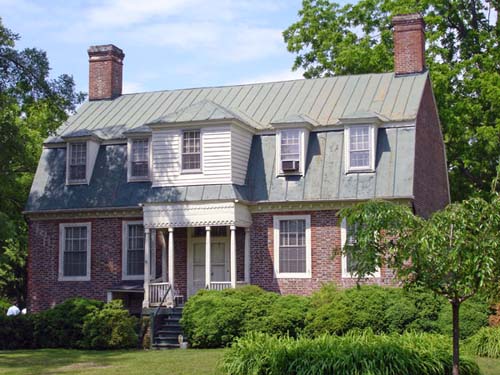 |
Shelton House |
The bus tours were Friday and Saturday. Friday was north of Richmond. We did a drive-by of the important rail crossing, Hanover Junction, which is now called Doswell for some reason. Our first stop was "Wyoming," an historic house that overlooks Nelson's Landing on the Pamunkey River. The owner of the house met us in period grieving-widow garb, allowed us to tour around, and was available to sign books that she had written about history in the area.
Next, we visited the Shelton House, which was not only Winfield Scott Hancock's Corps headquarters during the battle of Totopotomoy Creek, it was also the site of the 1754 marriage of Patrick Henry. (Only a few weeks ago, possession of the house transferred to the National Park Service. Already the NPS wags have identified the wedding ceremony room as the real source for Henry's "give me liberty or give me death" speech.) We stopped at Enon Church and dissected the battle of Haw's Shop, which is clearly visible down a long field that is owned by a local lady. Bobby Krick took this opportunity to tell me that he does not believe that Sgt. John A. Huff, supposedly the trooper who mortally wounded J.E.B. Stuart at Yellow Tavern, and who died in this battle, was credible as the shooter at Yellow Tavern. Lots of myths get deflated at these events. We drove by Old Church, where the May 30 battle occurred, and then headed for Cold Harbor.
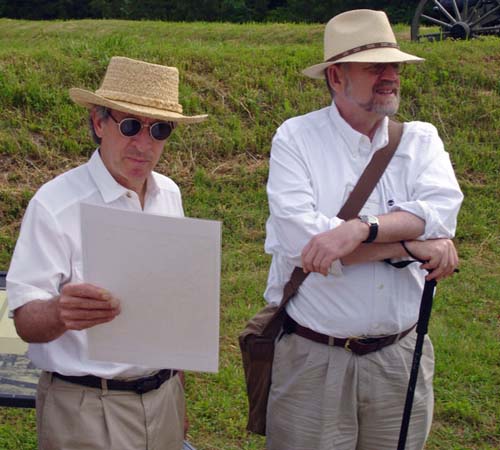 |
Gary Gallagher and Bill Bergen |
We had a box lunch outside Garthright house, a field hospital during the battle. All of the amputated arms and legs have been cleaned up by now, so lunch was pleasant. The NPS portion of the Cold Harbor Battlefield is quite small, considering that it is an important battle that was spread out over a front of 7 miles. Only a few acres of the fighting, near the center of the line, are preserved, along with some of the very dramatic earthworks constructed by both armies, which are eroded, but still quite visible. However, we were in for a treat. Bobby Krick had obtained permission from two local farmers to troop around on their land and we saw parts of the battle that most people never get to see. On the Allison Farm, we saw the field where the XVIII Corps (Baldy Smith) was slaughtered on June 3; of course, it is a farm field now, with none of the entrenchments remaining outside of the woods. Inside the woods, we saw some pristine artillery lunettes and also protection for their limbers. On the Adams Farm, we saw where Barlow's division assaulted Breckinridge and made some progress around Turkey Hill on the Union left flank, although it came to naught. We also saw a fine herd of "beeves." What is interesting about this part of the battlefield is that it is a two-fer: extremely nearby is the sunken road (which is sunken almost to the point of the railroad cut at Gettysburg) that was the Union defensive position at the battle of Gaines' Mill in 1862. All of the historians agreed that this is the most significant battlefield land still in private hands in North America. (There were no Canadian or Mexican historians present to dispute this.) The good news about our trip to Cold Harbor is that the severe thunderstorms that were forecast never materialized, although it was very humid and thus debilitating. The bad news is that I will have to redo my Wikipedia maps of the battle; I found a number of inaccuracies after seeing the ground in person. (I did update them 6/1/06.)
|
|
On Saturday we headed south to Petersburg. We started at battery number 5 at the National Battlefield, part of the original Dimmock Line of earthen defenses east of the city. We discussed the initial assaults by Baldy Smith's Corps on June 15, 1864, and walked along the batteries up through number 11, seeing where the United States Colored Troops overran the Confederate lines (which were grossly undermanned on that day). Robert Krick opined that Smith's failure to capitalize on this initial success was the greatest lost opportunity of the war in the East — 16,000 federal soldiers were faced by only 2,200 Confederates and PGT Beauregard admitted to Robert E. Lee that the crucial city was at the mercy of the federal commander. Next to battery 9 was a recently built replica that showed what the earthworks and chevaux de frise would have looked like around one of the batteries. We hiked down the Prince George Court House Road to see Meade's Station, a small piece of track representing where the US Military Railroad deposited supplies. (Gary told us that the US Military Railroad system was the largest railroad in the world at the time.) After another box lunch in a picnic area nearby, we went to the vicinity of Fort Stedman. The action of that fort would not occur until March 1865, so we bypassed it and instead examined the assaults of June 18, where the 1st Maine Heavy Artillery Regiment assaulted Hoke's Division. This large regiment lost more men in this assault than did any other regiment of the Civil War (in terms of absolute numbers, not percentages — 241 killed, all of whom are listed on a monument in their honor).
|
|
Jumping ahead in time to July 30, 1864, we visited the Taylor Farm, which is on the other side of Poor Creek from the Crater, and from where Union artillery bombarded the Confederate lines with a large number of guns after the Crater was exploded. (The National Park Service brochure says 200, Bill Bergen said 140.) We moved over to the entrance of the mine that they used to create the Crater and heard the familiar story about the 48th Pennsylvania Infantry and Colonel Henry Pleasants. Then we came upon the Crater itself. I last saw this landmark in 1970 as an ROTC cadet and it seemed to be a little smaller than I remembered, but the photographs that we passed around looked really horrendous. We heard some amusing stories about the golf course that used to be right next door, with the clubhouse directly next to the Crater itself. And some appalling stories in letters that Confederates wrote regarding the treatment of USCT soldiers who were captured. Quite a debacle.
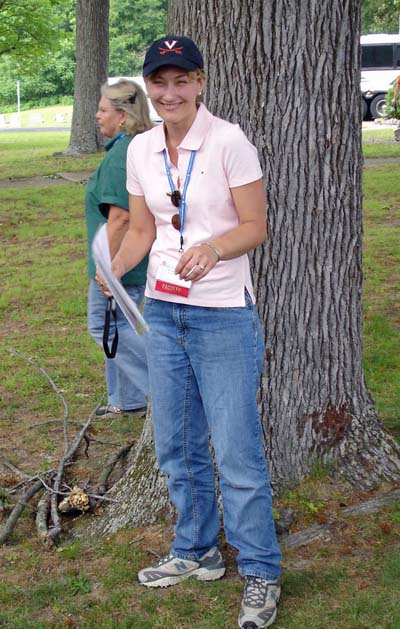 |
Carrie Janney at Blandford Cemetery |
We finished up the day on a lighter note by visiting Old Blandford Church and its cemetery. The church was built in 1735 and is now a Confederate Memorial. Louis Tiffany created 15 beautiful stained-glass windows that honored the Petersburg Ladies' Memorial Association and the states of the Confederacy, each represented by the state seal and a Christian saint selected by Tiffany. The cemetery is huge and contains over 30,000 Confederate dead, of whom only about 10% are identified. The mausoleum of Billy Mahone, hero of the Crater, is there, marked only by the single initial "M." Back on-campus, we had an excellent barbecue buffet outside in the quadrangle, entertained by a Civil War string quartet. We certainly lucked out on the weather. Every time we got out of the bus, we seemed to find ample shade or cooling breezes that made the day quite pleasant. I also finished the week feeling very full. The UVa staff kept offering food so frequently that I thought I was on a cruise ship. Groan.
There was a wrapup session on Sunday morning and it looked as if more than half of the attendees stuck around for it. All of the week's presenters were on stage and any questions at all were allowed. To my not-so-great surprise, only a couple of the questions concerned the campaign we had just studied. There was one really softball question about "Why should we study the Civil War?" and I was really amazed that no one answered it very well. If I had been asked, I'd say, "There are reasons why I want to study the war and reasons why I should. I want to be inspired by tales of bravery and revel in the hundreds of interesting and sometimes peculiar characters of the war. I know the geography and can walk in the footsteps of these men on ground that is better preserved than just about any war in history. I want to ask all the 'what-ifs' and second-guess the strategic and tactical decisions as an intellectual challenge. But as an American, I have a lot to learn that will be of value beyond mere interest. I need to understand how average men can learn to deal with extraordinary circumstances. How wars can be fought in the middle of extreme political strife. How men can deal with technological changes that turn their training upside down and make them engineer new strategies and tactics on the fly. How harnessing idealism can be turned into practical results. How our racial problems of the present came to be." In contrast, Bob Krick's answer was "My wife likes the income."
I type this on my trip home. I look forward to visiting Richmond on a future occasion.
(Note to my photo fans: I had hoped to include a photo of Bobby Krick's elderly father, but it's sometimes a challenge to frame good views when 120 people are crowding around. Maybe next time.)
Civil War Institute at Gettysburg College
I visited Gettysburg College for my second Civil War Institute. The theme this year is "Civil War Medicine and Antietam" and I frankly came more for the latter than the former. In preparation, as usual, I wrote some Wikipedia articles:
- Maryland Campaign
- Battle of Antietam
- Battle of South Mountain (although this one is still pretty short)
- Battle of Harpers Ferry
And I created a new T-shirt!
Sunday, June 25
Since the event starts midafternoon on Sunday, I had to fly out Saturday evening and I stayed at the Dulles Hyatt, which is a very nice, quiet hotel. Up early for some touring on the way, I found that a torrential rainstorm was in progress. My plans to visit Balls Bluff battlefield fell by the wayside, as did any casual hope of visiting Aldie or Middleburg. So I drove directly to Gettysburg and spent some time shopping at Wal-Mart for the necessities that make dormitory life tolerable. (See my complaints about the Gettysburg College dorm in last year's article.) It's good to report that my three former roommates are together with me again (and one new guy), so there's no awkward unfamiliarity and I can get right into my sophomoric humor (appropriate for a second-year attendee). I was asked to repeat one such here:
Roommate: I see that there were 17,000 freemasons at Gettysburg.
Hal: I wonder why they didn't build better breastworks. (yuck, yuck — well, you had to be there)
|
|
The afternoon started with an optional battlefield tour conducted by Chaplain Chuck Teague, with whom I have toured twice before, and he did an excellent job once again. His subject was the almost forgotten actions of von Amberg's brigade of the XI Corps on July 1, 1863. As ominous black clouds threatened, we walked out the Mummasburg Road and spent time finding their positions on the left of the 11th Corps line. Unfortunately, fears of lightning kept us from up walking as far away from campus as Chuck wanted and we ended up seeing some of the positions from afar.
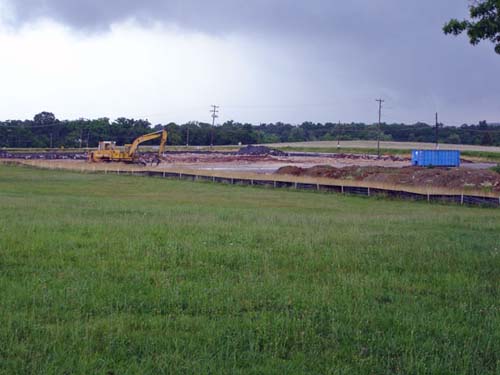 |
Remains of the Ford dealer |
I was delighted to see that the Ford dealership has finally been torn down and the Park Service will be restoring the land on the Carlisle Road to its original condition. They also removed 12 acres of trees from Oak Hill, which really opens up the vistas looking east, showing that the Confederates had a significant artillery advantage over the XI Corps. Chuck put a lot of emphasis on the actions of Hubert Dilger's batteries and on the heroic actions of the 157th New York, who suffered casualties only slightly lower (about 75%) than the more famous 1st Minnesota did the following day. Kudos to Chuck for pronouncing most of the German officers' names correctly! We were very fortunate about the weather because heavy rain started up only a minute or two after I reached the dorm.
That evening we had a barbeque, which was served in the lecture hall due to the rain. The campus is in an uproar as buildings are getting flooded out, including the dining hall. (It turns out that the entire mid-Atlantic region is reeling from heavy rains.) After our hotdogs and burgers, we had our first lecture, by Herschel Stroud, "Civil War Medicine: Cursed or Blessed?" which happens to be one of the dumber titles I've heard. It was a brief overview of the subject, presented in character and uniform of a U.S. Army major and surgeon. No color photos of patients, for which I was grateful.
Monday
We started with a college-cafeteria-quality breakfast and then opening remarks by the Institute director, Gabor Borritt. I swear his accent is getting thicker! The highlight of the day was James McPherson's talk on Antietam, despite being remarkably similar to the one he delivered in Charleston last year. He spent about 5 minutes on the battle and all the rest on its background and significance. McPherson is always able to deliver key insights very succinctly and illustrated his case with interesting quotes. (I had not heard Karl Marx's opinion on the battle before.) And I was able to jot down a few choice improvements I will make to my Wikipedia article.
The first of the lengthy breaks that plague this conference set in (10:30 - 1:30) so my group of roommates and I decided to skip the cafeteria and we drove off to the Farnsworth House, which has a great bookstore and a decent restaurant. Many of us had Pennsylvania Dutch specialties; mine was sauerkraut mixed with ground pork.
The afternoon program was Gordon Dammann, the founder of the Civil War Medicine museum in Frederick, MD, who gave an excellent overview of CW Medicine. (Apparently the little major last night was just a warmup act.) I wound up being very impressed with the career of Dr. Jonathan Letterman. I had no idea he introduced so many fundamental innovations to emergency medicine, most of which started at Antietam—triage, multilevel treatment and evacuation, and a dedicated corps of ambulances. A funny insight was that doctors of this time generally sought to induce PPP (poop, pee, and puke) to purge patients of their ills. More serious is that amputations without anesthesia were basically a Hollywood myth, as was "biting the bullet." Dammann's lecture was followed by an odd panel discussion in which the all-doctor panel never did much more than ask Dammann questions. Dammann was very impressive, although his heavy knowledge of Union medical practice was not matched by his Confederate.
Left with another big block of time, some of us bailed out of a huge cafeteria line and went to Dino's for pizza and then skipped the evening lecture (Carol Murphy, "CW Meds: A TV Series in the Making") to go instead to Tim Smith's lecture at the Middle School. Tim had a big collection of photographs of famous farms on which the battle was fought, along with a lot of interesting anecdotes, such as how two children who were at the battle mysteriously turned up in 1992, aged not a day!
Tuesday
Today was our full day of battlefield touring, always a highlight of the week. We awoke to heavy rain, but it dissipated by the time we were on the buses. A nice morning that turned into intermittent torrents in the afternoon.
|
|
My tour was with James McPherson, titled "Battle of Antietam and Medicine," but the medicinal portions were thankfully slim. We drove out through Boonsboro and Turner's Gap on US Alternate Route 40 to get to Sharpsburg. I had been there once previously, but it was a short, car-bound visit. What a beautiful locale. And nowhere near the commercial encroachment from which Gettysburg suffers. Rolling hills, mountain vistas, a river (creek), pristine farms, stone bridges. Although Shiloh is recognized as a beautiful battlefield, I prefer Antietam because you can visualize so much so easily.
McPherson did an excellent job of explaining the context and strategies and some of the confusing battle details. We mostly followed the Park Service auto-tour stops (pretty necessary when you have a big bus), which means we went chronologically through the day, starting with Hooker's assault through the Cornfield, then the West Woods, and the Sunken Road. I was a bit nonplussed that he spent time grousing about not having copies of maps to hand out, when I was wearing my full-color battle overview tee-shirt that he could have called me up to display. Actually, my shirt got very little comment from anyone.
We interrupted the chronology to zip over to the Pry House, McClellan's headquarters, but also a former field hospital, where a branch of the CW Meds museum has exhibits. We heard a great talk by George Wunderlich, who as an EMT holds Jonathan Letterman in awe. All emergency medicine uses the Letterman Plan today, 144 years later. (I suggested to George afterwards that he use a 'Top Ten' list in his talk about Letterman and he obviously never made the connection before.) George is also an avid historic banjo enthusiast and builder and he favored us with a tune. It wasn't from Deliverance. One of the exhibits there said that there were 50,000 amputations during the war and 95% used anesthesia.
We had a box lunch and took off for Burnside's Bridge, everyone's favorite at Antietam. But the rains returned before we could trek the Final Assault walk, so we did it safely by bus. (I say 'safely' because this was a thunderstorm and I was the tallest guy there. We all had raingear, but we weren't suicidal.) We adjourned to the Visitor Center to watch their really mediocre, 30-year-old movie, "Antietam Visit," and then the skies cleared long enough to walk out to the 9th NY Zouave monument, the "High Water Mark" of the IX Corps advance. I managed to suspend my better judgment and get in a crack at JM's expense (which is sort of like tugging at Superman's cape or spitting into the wind). He spoke an oddly constructed sentence in which "Lee was planning to attack himself" and I said "Attack himself? How aggressive was this guy anyway?"
Back on campus, the after-dinner lecture was by Thomas Lowry, entitled "Sexual Debases in the Civil War," which I presume was a typo, but he didn't explain. It was about prosecutions of sexual perversions in Gettysburg. Not by the soldiers, who were too busy fighting, but by randy civilians. I learned that "F&B" is 19th century legal speak for "fornication and bastardy." Useful for social conversations back home. And we heard about a case of buggery with a sheep. Let's get back to amputations...
Wednesday
Today was a full day of lectures about medicine, so some of us played hookie. I did get some reactions from those who stayed:
- Ira Rutkow, author of Bleeding Blue and Gray, talked about how no real medical innovations occurred during the war, but how it opened up study that led to big ones soon after. Well received.
- Craig Schneider, a student, on Pennsylvania Hall (of the college) used as a Confederate hospital. Everyone said this was the best of the day and the kid really did his research and presented well.
- Ken McAllister on "Joshua Lives, Stonewall Dies," and Sharon Van Meter on "CW Wounds," both of which had lots of gruesome wound photos. Not too popular.
- Three CWI alums who talked about medical experiences in Korea, Vietnam, and the Gulf War. So-so.
- Judith Ann Giesberg on the Sanitary Commission and Jane E. Schultz on women working in the hospitals. Both of these got really bad reviews. Poorly presented and way too long, particularly for after-dinner sessions.
|
So I don't feel bad about missing any of these. My friend Don and I drove to Carlisle and spent a good part of the day at the US Army Military History Institute, where we looked for interesting old photos in their voluminous archives and Don used his fancy camera and document stand to take high quality copies for me. On the way back we swung west through Chambersburg and back through Cashtown, where I wanted to see the historic Inn. We were surprised to find that there was rubble in the street after 2.5 feet of water surged through yesterday. The Inn had a firetruck out front pumping out water.
All the news on TV in the dorm (which we can see but not hear—no remote control and it's stuck on mute-closed-caption) is about flooding, particularly on the Susquehanna. Not many problems to report in Gettysburg, except for soggy areas on the battlefield. Marsh Creek and Rock Creek are roiling brown torrents. However, the big annual battle reenactment has been postponed for a week due to the muddy fields on the farm they use. This will cause lots of consternation for reenactors and tourists alike.
For dinner three of us drove to the Fairfield Inn and had a good meal. It included pumpkin fritters! Delicious, like beignets. Then a beer at the Reliance Mine bar, a local dive. Bill Frassanito, the author famous for photography books, was there, as was John Archer, who has written books on Culp's Hill and Cemetery Hill.
Thursday
We started with a selection of half-day tours of Gettysburg. Some were medically oriented, such as Greg Coco's tour of field hospitals, but I chose to go with Ed Bearss to East Cemetery Hill. My great admiration for Ed was described in last year's travelogue, but he's still going strong, celebrating his 83rd birthday this week. I've toured ECH before, but this was a different approach. Most tours lead you along Brickyard Lane, following the advance of Hays's Louisiana Tigers. But we traveled through the fields with Isaac Avery (Hoke's Brigade), dodging cow pies, disassembling fences, and sloshing through wet ground around Menchey's Spring. We detoured over to Stevens Knoll to see from where they were hit by enfilading artillery fire, then back down the Lane and up the hill. Then, by bus over to the Daniel Lady Farm, which was Ewell's headquarters, but also a field hospital (where the Boy Major, Joseph Latimer, was treated), and briefly to Benner's Hill. We returned to a birthday party for Ed at the cafeteria.
|
|
The afternoon was officially free. Three of us went to Monterey Pass to see the site of a cavalry action during Lee's retreat. Troy Harman is doing a big battle walk there this weekend and gave us some advice on what to see (although there isn't too much visible), since none of us will be here long enough to attend. On his recommendation, we visited High Rock in northern Maryland, near Ft. Ritchie. It's a cliff about 3,500 feet high and offers a spectacular view of the Cumberland Valley (and great hang gliding, which we did not attempt).
I skipped out of the annual auction after dinner. There was nothing particularly interesting being offered and I rarely bid at auctions anyway. Instead, I met downtown (the infamous Mines again) with a guy I knew only through Wikipedia, Scott Mingus, a big wargaming author and quite an expert on cavalry in general and the whole Gettysburg Campaign in particular. I also finally met R.L. Murray, the New York author who happened to be the high school history teacher for my niece. I enjoyed his book about George Sears Greene at Culp's Hill. Meeting R.L. was quite a coincidence because we linked up through one of my roommates, also from New York state. Both are really nice guys and I hope to keep up a correspondence with them.
Friday
My friend Don and I ate breakfast with Troy Harman. He has pitched a concept to us that we should write Civil War travel-related articles (like this one) for a book to be illustrated with Don's photography. I remain rather skeptical of the commercial prospects for such a venture, but Troy's enthusiasm is always contagious, so it's something I'll consider.
The morning lectures started with a brief speech by Jeff Shaara, who announced that the Michael Shaara (his Killer Angel father) Prize for fiction will go this year to The March by E.L. Doctorow. But the highlight was Doris Kearns Goodwin, whose Team of Rivals (about Lincoln and his cabinet) is winning the Lincoln Prize this year. This was the best speech I have ever heard at a Civil War conference and probably one of the best I've heard anywhere. Her long experience on TV political talk shows has paid dividends, I guess. Extraordinarily well-spoken, humorous, incisive. One hears that so-and-so constructs spoken full sentences well, but she must think in well-constructed paragraphs. I don't know how much of her base speech she has memorized over the months, but her responses to questions was equally impressive.
|
|
After Doris, I said goodbye to my friends and hit the road. All I missed was another cafeteria lunch, a speech by Eric Dean on Post-Traumatic Stress Disorder, GNMP Director John Latschar on the new Gettysburg Visitor Center, and the closing banquet. Instead, I spent some time in Frederick, MD. I visited the CW Meds museum and was impressed. It's rather small, but covers all the subjects well with posters, exhibits of artifacts, and dioramas. I learned a few interesting things. Prior to the war, hospitals were rare in America. They were considered places to send dying people or those needing quarantining. Also virtually unknown was embalming. The Army of the Potomac served approximately 1,500 days, but only 45 in combat, meaning that during the remainder they had to fight diseases.
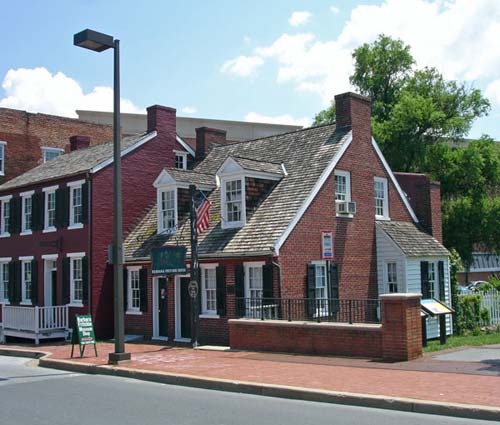 |
Barbara Fritchie House in Frederick |
Then I visited the Barbara Fritchie house. The 95-year-old widow supposedly defied the Confederates marching through town on the way to Antietam when they got mad at her display of the U.S. flag. "Shoot, if you must, this old gray head, But spare your country's flag" says the famous poem by Whittier. The docent recited the full poem for me with great dramatic flair and we also jousted about CW history. The highlight of the visit was finding a large map of Gettysburg upstairs, autographed by George Meade. It was really unusual, with three-dimensional effects for the terrain, depicting the battle from a viewpoint a thousand feet or so above Rock Creek, looking west. The docent said she knows of nowhere to get a print of it.
Alas, I had used all my time and I was concerned about 4th of July holiday crowds at Dulles, so I once again had to foresake Ball's Bluff. So near and yet so far. Maybe someday...
West Coast Civil War Conference
Here I am again after a long absence. Some pressures at work have kept me from doing any significant personal travel. This will undoubtedly be my last entry for this year.
Almost by chance, I found an invitation to a conference held annually by the Sacramento Civil War Roundtable, so since it was reasonably local, I decided to give it a shot. I am glad that I did because this conference was pretty well organized, had probably 150 friendly folks (a number from the San Francisco Peninsula whom I had not met previously), and had a very interesting set of presentations and other activities. The conference theme was the oddly worded Aspects of The War on the Water.
|
|
Friday, November 10
We convened at the Doubletree Hotel in Sacramento for a social hour and dinner (most of which I missed due to horrendous traffic). We had one speaker after dinner:
- Craig Symonds - New Technology and the Civil War at Sea. Craig is a former professor of history at the Naval Academy and is the chief historian at the Mariners' Museum in Newport News, Virginia. He was easily the best speaker of the weekend and one of the best Civil War speakers I have had the privilege of witnessing. Very animated, extremely well spoken, and humorous. He started with some general comments about the introduction of technology in the war, but the vast majority of his talk concerned the Battle of Hampton Roads, otherwise known as the Monitor versus the Virginia (or Merrimack). I was struck in particular by one statement he made, that the loss of the Cumberland and the Congress to the Virginia on March 8, 1862, was the most significant defeat for the United States Navy before December 7, 1941.
Saturday
- Jim Stanbery - Union and Confederate Naval Strategies. Jim is a professor at Los Angeles Harbor College and has been presenting at the West Coast conference for 20 years. He gave a brief overview of naval strategies, intended primarily as an introduction for the other speakers.
- Kevin Foster - The American Civil War and the Maritime World: Incidents in International Law and Diplomacy. Kevin has a degree in underwater archaeology and heads the Marine Heritage Program of the National Park Service. He gave what I thought was, unfortunately, a relatively dry presentation that included topics such as the Declaration of Paris on maritime law, privateers, responsibilities of belligerents and neutrals, and the Trent Affair.
- Dennis Ringle - The Union Blockade: Success or Failure? Dennis is a retired U.S. Navy Commander and the author of Life in Mr. Lincoln's Navy. He gave an animated presentation about the Union blockade. Although he hedged his bet on its success or failure, he implied pretty strongly that it was a success. Although most blockade running ships were captured after an average of two round trips through the Union lines, there was one ship (the name escapes me) that made over 90 trips. Unfortunately for the Confederate military, many of the successful trips were carrying luxury items, such as cognac or perfume. An interesting tidbit was that by the end of the war, 18 to 20% of the US sailors were African-Americans.
- Kevin Foster - The Navy They Wanted, The Navy They Got: Confederate Ship Buying in Europe. Kevin returned after lunch (always a bad time for a presentation) to describe some of the famous Confederate ships, particularly the commerce raiders, and how they were procured. It must be difficult to arrange interesting naval presentations about the Civil War, because all of the sailing ships look pretty much the same when presented as drawings.
- Dennis Ringle - Life of the Common Sailor During the War. Dennis became even more animated in a humorous presentation about recruiting sailors and what life was like below decks. He concentrated almost exclusively on the Union Navy.
- Craig Symonds - The Battle Against the Shore: US Navy Attacks on Confederate Ports. Craig concentrated on two major amphibious operations: the Port Royal expedition and the Battle of Mobile Bay.
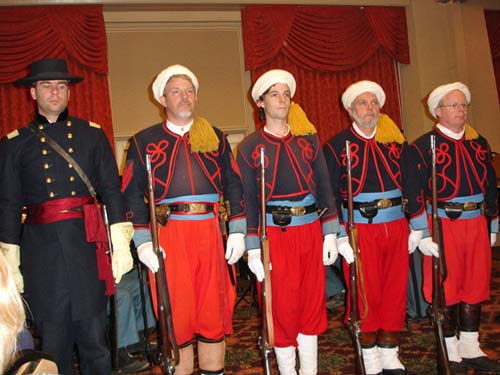 |
Zouaves before the banquet |
Saturday night was a banquet, preceded by an interesting hour of Civil War music played by a group calling themselves the 5th California Infantry Band; the bandmaster confessed that for other occasions they are also prepared to represent the 43rd Virginia Infantry or a group of California gold miners. They played a few old favorites, but also reached deeply into obscurity. My favorite was a very elaborate piece commemorating the Battle of Port Royal, laid out in little acts, similar to the type of music played to a silent movie. We also got to see a small group of Zouaves marching around, accompanied by three lovely ladies in giant hoop skirts.
- Ed Bearss - The Raising of the Cairo. After dinner, the famous Ed Bearss recounted the brief history of the USS Cairo, the first ship in history to be sunk by a mine (called a torpedo in those days). Fifty years ago from that very night, Ed used a World War II compass to locate the wreck of the Cairo in the Yazoo River and the remainder of the talk was a slideshow about all of the difficulties raising her from the mud. Her remains, being restored slowly, are on display at Vicksburg National Military Park.
Sunday
- Craig Symonds - River War: The US Navy on the Upper River System. Craig's third presentation covered the river battles at Fort Henry, Fort Donelson, Island Number 10, and, most interestingly, Memphis. To the amazement of the Navy, the Army ramming boats under Colonel Charles Ellet, Jr. almost single-handedly destroyed the rebel fleet defending Memphis, with only a single casualty—Ellet himself, mortally wounded by a pistol shot.
- Ed Bearss - Vicksburg and New Orleans. Ed's final presentation
covered Farragut's
capture of New
Orleans in the failed naval activities
at Vicksburg that preceded Ulysses S. Grant's campaigns against the city.
I had to hit the road to make it home, so I missed the modest Sunday brunch, a raffle for a number of interesting books and gifts, and a panel discussion by the presenters. But even missing these events, I had an excellent time and hope I will be able to attend a future West Coast Civil War conference. They are apparently in different cities every year and the 2007 conference will be in Las Vegas.
